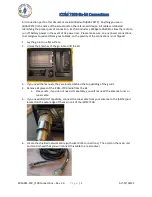
Stratos Multi E401N
215
14 Basics
14.1 Basics of PID Control
Control is only possible in a closed control loop. The control loop is made up of individual compo-
nents, which must be permanently ready for operation. The variable to be controlled (controlled
variable) is continuously measured and compared with the specified setpoint. The aim is to equalize
the controlled variable and the setpoint. The resulting sequence of action takes place in a closed loop,
the control loop.
The controlled variables (e.g., pH value, temperature, concentration, etc.) are measured by suitable
sensors, which supply the continuously measured value for comparison with the specified setpoint.
The comparison is carried out at user-defined time intervals. Deviations trigger a control process with
the aim of adjusting the controlled variable to match the specified setpoint within a specified period
of time.
The controller compares the controlled variable with the setpoint and feeds back the result to
influence the controlled variable.
Controllers are classified according to the criteria of characteristic, dynamic response, operating mode.
• Characteristic: A distinction is made between continuous (linear) and discontinuous controllers.
• Dynamic response: The change of the control difference variable at the controller input influences
the manipulated variable at the controller output.
The linear controllers are classified according to very different criteria. Their dynamic response,
however, is of primary importance.
In the following, basic dynamic components and their typical combinations are described.
P Controller (Parameter: Controller Gain)
The proportional action of an independently operating functional unit of a P controller converts the
control difference variable into a proportional manipulated variable. The control signal is limited to a
maximum value (range of the manipulated variable). Accordingly, the controller input signal has a
maximum usable input signal range (control range).
I Controller (Parameter: Reset Time)
The integral action, also an independently operating functional unit, takes into account the time
change (rate of change) of the manipulated variable, i.e. the time integral of the control difference
variable. Each value of the controlled variable is assigned a specific value of the control speed.
PI Controller
With these controllers, the proportional and integral action is added together. In contrast to P
controllers, which only have a proportional relationship between the controlled variable and the
manipulated variable, the time is also integrated. The value of the manipulated variable is determined
proportionally to the control deviation, and the integral action is also added.
D Control (Parameter: Derivative)
A D control (differentiating control) is completely unsuitable on its own, as it only responds to changes
in the control difference variable, i.e. it is unaffected by a constant control difference variable.
PD Controller
With this controller, the proportional change of the input signal and the rate of change of the con-
trolled variable are added to the resulting manipulated variable.








































